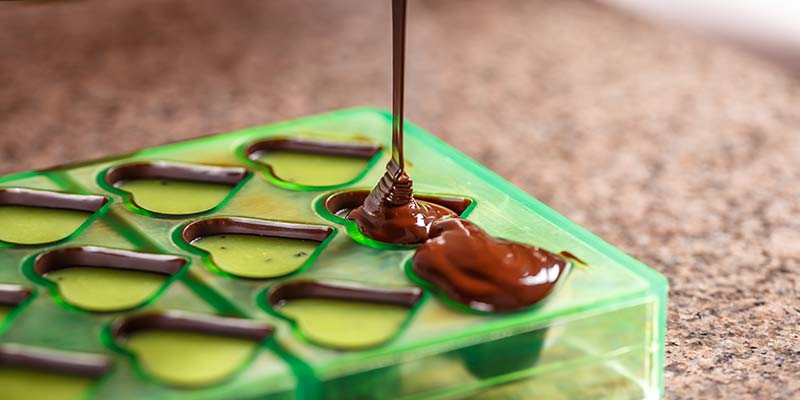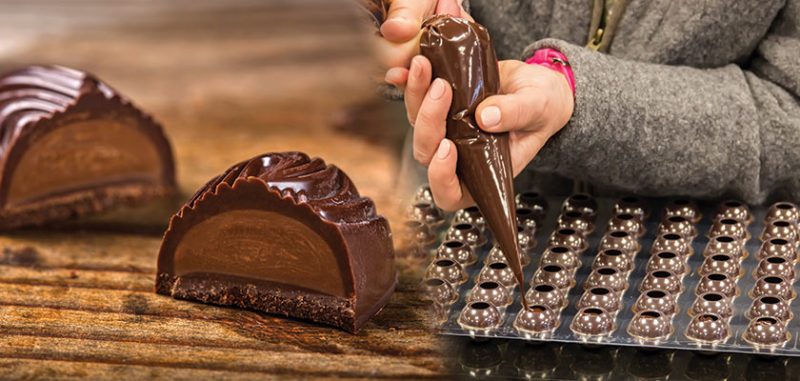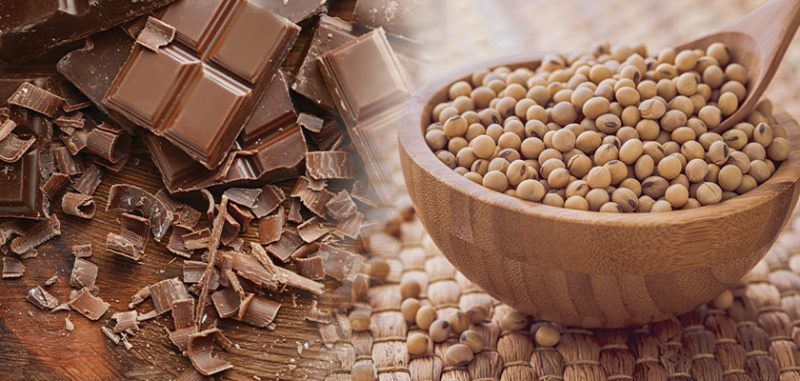At some point in your chocolatiering journey, you’ll wonder what’s the best chocolate for molds. Professional chocolatier Simon Knott discusses the best kinds of chocolate to use in molds, and brands of couverture to invest in.
If you’ve recently started making chocolate in molds, you may feel that your finished chocolates could be a bit better. That’s just a natural part of honing your craft. As we get more practice and experience, we want better results from our work.
One of the ways we can do this is by investing in high quality chocolate designed for molding work, and gaining a deeper understanding of the chocolate science underlying it. Choosing the best chocolate for molds is more than just picking the best brands, but more about understanding how fluidity, manufacturer ratings (eg teardrops) and cocoa butter content influence the quality of your molded chocolates.
In this article, our lovely chocolatier Simon Knott explains all of this to help you select the right kind of chocolate to use in molds, tips for preparing couverture chocolate correctly prior to molding, and a few of his personal brand recommendations.
What is the Best Chocolate for Molds?
Article by Simon Knott, Professional Chocolatier
Molding chocolate first started around 1835 in France with simple geometric designs aimed at the mass market. At the time, most European towns had several chocolate shops and the competition between them encouraged chocolatiers to innovate with new mold designs to appeal to their customers. Often, the mold designs would tell a local story or represent folklore tales.
These first molds were made of steel or copper with a thin tin coating, making a glossy chocolate surface. The metal molds lasted into the 20th century when they were superseded by polycarbonate and silicone designs, which were easier to work with and easier to remove the set chocolate from.
There are several different types of molds for different applications; each requires different techniques and chocolates to ensure quality products. Mostly, these differences are down to the physical characteristics of the molds and the fluidity of the chocolate used to fill them.
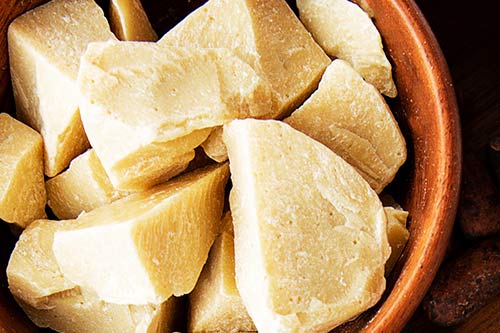
Best Kind of Chocolate to Use for Molds
The best kind of chocolate to use for molds generally needs to contain a higher percentage of cocoa butter to perform well with the physical requirements of a mold. However, this is not always the case.
Applications Where LESS Cocoa Butter is Better
- Larger molded figures (eg large eggs, display pieces)
In some applications, low-fluidity (or thicker) chocolate with less cocoa butter may not offer such a shiny finish. However, its benefit is creating a thicker chocolate shell with one coating, meaning a second coat isn’t required, so saving time. This tendency makes low-fluidity chocolate the ideal choice for larger moulded figures.
A mid-range fluidity chocolate is a good choice for more general molding work, where versatility is key. Such chocolate enables the chocolatier to take advantage of the best attributes of both low-fluidity and high-fluidity chocolate couverture at the same time.
Applications Where MORE Cocoa Butter is Better
- Smaller, delicate molding work
- Intricate shapes
High-fluidity chocolate with a higher percentage of cocoa butter performs much better when used to create thin and strong chocolate shells, such as handmade chocolates, which have the strength to contain soft fillings.
Higher cocoa butter content creates stronger fat crystals, giving the chocolate better strength and rigidity. High-fluidity chocolate is also the best option when filling angular or complex molds, with its better coating and penetrating ability in the tight corners of the mold.
Couverture Chocolate
Couverture chocolate is a good example of a higher cocoa butter chocolate. It’s named after the French word ‘couverture’, which means to coat or blanket. With its higher cocoa butter content, couverture tends to be more expensive and has a richer and smoother mouth feel, so it is often associated with upmarket products.
Types of Couverture Chocolate
Couverture chocolate can be made as dark, milk or white chocolate. Dark couverture chocolate is noted for its richness and cocoa intensity. Milk couverture tends to be lighter and creamier, while white couverture has a delicious buttery flavour and rich texture in the mouth.
Couverture Chocolate Ingredients
By altering the cocoa butter content, the coverability and fluidity of the melted chocolate can be adjusted for different molding applications. Under European Union regulations, couverture chocolate must have at least 35% cocoa solids and at least 31% cocoa butter, although between 32-39% cocoa butter content is more usual.
Alternatives to Couverture Chocolate
High quality couverture is certainly the best chocolate for molds, however, incorporating cocoa butter into your own chocolate is quite straightforward. There is no reason to stop buying your own food-grade cocoa butter and adding it to your chocolate as an easy way to increase the fluidity of any batch.
The cocoa butter can be grated to speed up its incorporation into the chocolate. Start with small quantities (e.g. half a tablespoon) and stir to dissolve, while noting the increase in fluidity. If necessary, add more but slowly and stirring to dissolve in between. You can always add more but you can’t take it out if you add too much.
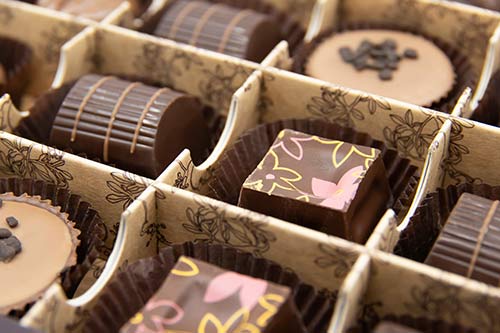
How to Choose the Best Chocolate for Molds (Couverture)
Chocolatiers involved in molding understand the need for fluidity when making their chocolates. Consequently, leading couverture brands have developed their own way of defining the chocolate fluidity on their packaging.
For example, Cacao Barry and Barry Callebaut use a scale of 1-4 teardrops to denote the fluidity of chocolate, where 1 is the least fluid recipe.
Other factors to evaluate when choosing the best couverture chocolate for molds:
- Choose the best quality couverture chocolate you can afford. It will have been developed to perform well and consistently in molding applications.
- The chocolate needs to melt and temper evenly to coat the mold thoroughly. It is the cocoa butter content that gives chocolate its coating ability.
- The molded chocolate needs to have a glossy surface, and snap when broken.
Why Does this Matter? Couverture Science
As the chocolate cools and sets, it gains good structural strength for handling from the crystal structure of the cocoa butter, which helps create the structure of the shell. When setting, the chocolate contracts slightly away from the mold, which makes for easier release. As the cocoa butter crystals form in the cooling chocolate, they naturally interlock, creating an efficient structure, which takes up less space and hence the slight shrinkage.
The chocolate needs to develop a good physical crystal structure during setting so the outer surface has a high gloss and the chocolate has an enjoyable snap when you bite into it. Often, it is the contrast between the snap of the chocolate and the smooth filling that creates such a pleasing combination in the mouth.
Cocoa solids percentage
The concentration of cocoa solids in couverture chocolate doesn’t directly affect how well that chocolate performs in molding. However, if a high percentage of cocoa solid chocolate is used, additional sugar may need to be added to counteract the bitterness.
This extra sugar will thicken the chocolate’s fluidity, which may, in turn, affect molding performance, depending on the application. If the sugar’s thickening effect compromises the molding performance, a small amount of grated cocoa butter can be melted into the chocolate to reverse the effect readily.
Best Chocolate for Molds – My Brand Recommendations
UK/Europe Brands
Barry Callebaut
Dark Chocolate
- Dark chocolate low-fluidity for molding
- 50.4% cocoa solids
- Read more on the Barry Callebut website
Milk Chocolate
- Milk chocolate low-fluidity for molding
- 28.4% cocoa solids
- Read more on the Barry Callebut website
White Chocolate
- White chocolate low-fluidity for molding
- 25.2% cocoa solids
- Read more on the Barry Callebut website
Luker Chocolate
Dark Chocolate
- Dark couverture chocolate mid-fluidity for molding
- 58.0% cocoa solids
- Read more on the Luker website
Milk Chocolate
- Milk couverture chocolate mid-fluidity for molding
- 45.0% cocoa solids
- Read more on the Luker website
White Chocolate
- White couverture chocolate high-fluidity for molding
- 36.5% cocoa solids
- Read more on the Luker website
USA Brands
Guittard
Dark Chocolate
- Dark mid-fluidity Madagascar Couverture Chocolate
- 64% cocoa solids
- Read more and purchase on the World Wide Chocolate website
Milk Chocolate
- Milk couverture chocolate mid-fluidity for molding
- 40% cocoa solids
- Read more and purchase on the World Wide Chocolate website
White Chocolate
- White couverture chocolate high-fluidity for molding
- 35% cocoa solids
- Read more and purchase on the World Wide Chocolate website
Tips for Using Chocolate in Molds
With the recent development of food colours and many innovative chocolate fillings, the range of filled chocolates available to the chocolatier has grown exponentially. Traditional styles such as ganaches and pralines are still popular, but there are now many more fillings and styles to use.
Here are some tips for using couverture chocolate in molding. For a step-by-step tutorial on making chocolates, see Chef Prish’s article on how to mold chocolate.
Selecting and Preparing the Mold
Polycarbonate molds are ideal for making filled chocolates. The interior mold surface can be polished with a dry cloth to ensure a mirror finish. Additionally, polycarbonate plastic cools more slowly than chocolate, making the chocolate easy to release from the mold.
A more fluid chocolate with a higher cocoa butter content is best.
A three or four-drop fluidity is ideal.
Just before filling, heat the molds briefly, so their temperature matches the tempered chocolate temperature. This should stop any temperature shock, which may throw the chocolate out of temper. and create a poor surface finish or grey mottling.
Using Fillings
When filling the cases, make sure the filling is smooth so it can be piped cleanly into the chocolate shells.
Ensure the filling isn’t hotter than 28°C (82.4°C), or it will likely melt the shells.
Avoid getting filling on the chocolate rim. When it comes to closing the shells with a layer of liquid chocolate the spilt filling will inhibit a good closure between the chocolate shell and the base, resulting in leakage.
Fill the shells with filling, but always leave a 1.5mm (1/16”) gap from the rim. When the shell is closed with a layer of liquid chocolate, the chocolate contraction will use this gap for a proper closure.
Chocolate Temperature
During the molding process, the best melting chocolate for molds must be held at the specific tempering temperature for that chocolate.
However, research has shown that when a molded chocolate bar was examined after cooling, the chocolate next to the mold surfaces had more of the desirable V structure fat crystals, which are associated with a glossy finish and a good snap when bitten into.
In contrast, the chocolate surface exposed to the air was a less organised structure with irregular crystals. The interior of the chocolate bar was also tested, and was found to be made up of a combination of both the V structure crystals against the mold walls, and looser crystals next to the air interface.
Although it hasn’t been scientifically confirmed, researchers believe the heat retention between the mold wall and the chocolate creates the optimum conditions for the best V structure crystallisation to occur evenly. The chocolate and the air interface has no such temperature control, so crystallisation is much more haphazard.
Conclusion
We hope you’ve found this article on what kind of chocolate to use for molds, from chocolatier Simon Knott, helpful in guiding you on the next part of your chocolate crafting journey. To recap the major points:
- The best chocolate for molds is high quality couverture (dark, milk or white).
- For delicate molding work, the chocolate requires high fluidity and cocoa butter content.
- For exceptional results, opt for couverture from brands Barry Callebut, Luker and Guittard.
For instructions on molding chocolates with a professional finish, make sure to visit Chef Prish’s article on how to mold chocolates if you have not already.
Also, make sure you know how to temper chocolate correctly, before you start experimenting with higher quality couverture chocolate. If you don’t, we suggest that you practice tempering with lower quality couverture, before moving over to the professional stuff.
And lastly, if you’re ready to start making, check out these instructions for making your own custom mold designs with Simon.
Happy chocolatiering!

